ASUS N10JC: the Netbook Goes Corporate
by Jarred Walton on December 24, 2008 4:00 AM EST- Posted in
- Laptops
LCD Quality
We've already praised the LCD quite a bit during our subjective evaluation, but we also ran our standard hardware tests as well. As usual, we test with ColorEyes Display Pro with two colorimeters, the DTP-94 and the i1 Display2. Results below are for the best performance out of these two colorimeters -- in most cases the DTP-94 leads by a small margin.
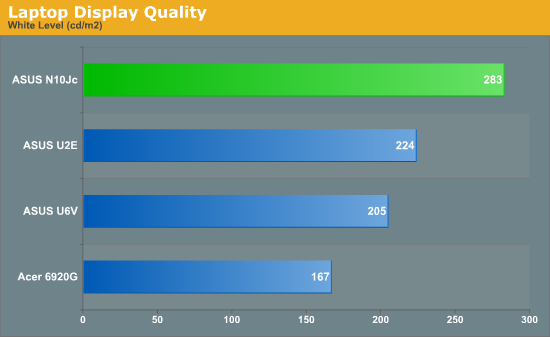
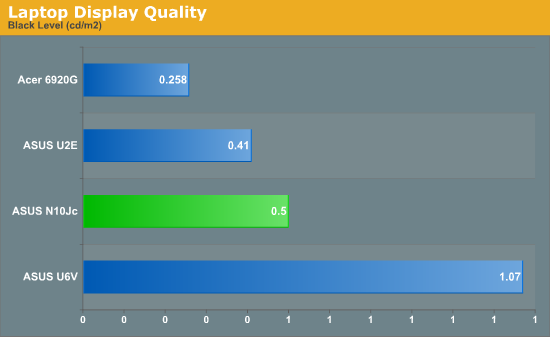
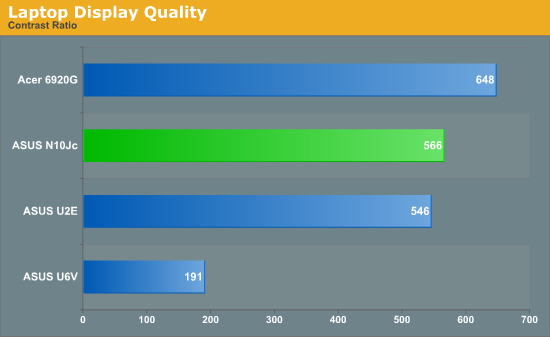

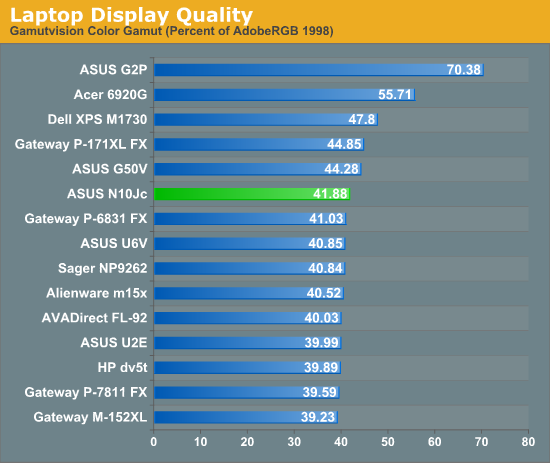
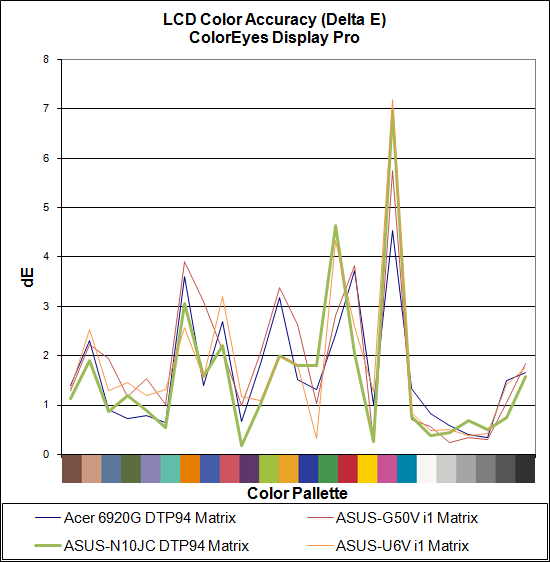
Color accuracy is very good for a laptop; the N10JC places at the top of the color accuracy charts for tested laptops. Color gamut unfortunately is only middle of the road -- and we're still waiting for a laptop that can manage anything above 80% color gamut. What's really impressive to us as the brightness level, reaching nearly 300 nits! Now you're probably thinking, "Fine, but what does that do to battery life?" That's what was really surprising: power draw only increases by ~2W, and battery life dropped by less than 20 minutes. We know plenty of people that don't like reflective screens, but other than working in very bright light (i.e. outdoors in the sunshine) the high maximum brightness can generally overcome any reflections. And if you're working indoors, you can still easily turn down the display brightness to a more comfortable level.
We would still love to see a high color gamut LCD in a laptop -- and something other than a TN panel would be awesome -- but outside of that the display on the N10JC is about as good as it gets. We also noted that vertical viewing angles were much better than any of the other TN panel laptops we have around. Hopefully we can start to see other laptops with similar quality displays, only with higher resolution, larger LCD panels.










45 Comments
View All Comments
DILLIGAFF - Wednesday, December 24, 2008 - link
Thanks for listening :)i checked the download page and the utility is called power4gears hybrid under utilities for n10jc. in the utility you go to performance and in lower left there is a turbo dropdown. change it and save. i used cpuz to verify clocks
supposedly there is a way to wire it to the power profile button but i gave the laptop to my girl before i could get it all done
DILLIGAFF - Wednesday, December 24, 2008 - link
looks like vista only...my bad...ouchpattycake0147 - Wednesday, December 24, 2008 - link
The text of the article on page makes mention of a Western Digital drive while the specs and picture show a Seagate drive. You might want to change the WD to Seagate.Khato - Wednesday, December 24, 2008 - link
Just wondering why the article is stating that the 945GME chipset is used, contrary to Asus' spec page which has it using the 945GSE? Sure it's not all that much of a difference, just 1 watt on the TDP and a smaller package.Still find it annoying how many manufacturers are unwilling to touch the US15W. I'm guessing the combination of it only supporting 1GB of memory (really don't understand why that design decision was made) along with it costing more is the reason...
JarredWalton - Wednesday, December 24, 2008 - link
Fixed... I'm guessing the 1GB limitation is exactly why companies stay away from the US15W. Like you, I'm a little surprised that Intel didn't support 2GB with the chipset; I mean, how much of a change would that be? Still, the next generation Moorestown platform should hopefully correct the power requirements of the chipset.Khato - Thursday, December 25, 2008 - link
Well, the reason for limiting the configuration to 1GB was almost certainly to save a pin. Support for 2GB would require one more addressing pin, which in a low cost product is significant. It also may well have been somewhat a marketing decision - it's a constraint that can keep the platform from growing upwards too far performance wise.Hopefully Moorestown allows for 2GB of memory, but it may very well stay at 1GB. After all, that's still more than enough for the intended market, and I believe you'll be stuck with whatever Intel provides for the chipset.
iFX - Wednesday, December 24, 2008 - link
... but smaller companies might.Large corporate IT departments have their own "procurement" sub-groups which handle IT equipment purchasing. These groups generally buy in bulk, say 100-200 notebooks at a time from companies they have service contracts with like HP and Dell. They buy for considerably less than what consumers pay in the retail channel. For $700 they can buy a considerably better equipped notebook. These groups generally make purchases with a "one size fits all" attitude, therefor, netbooks are out as a software developer won't want to be doing all his work on a tiny netbook - the same goes for an accountant or an attorney.
Small companies like AnandTech for instance might buy these new netbooks because they don't have sophisticated infrastructures, large numbers of employees, huge service contracts and IT purchasing can be done on a more personal level - many times with the actual employee making the purchase. Equipment, models, brands, etc are not uniform in small companies.
iFX - Wednesday, December 24, 2008 - link
And on top of all that... keep in mind that 99% of large companies operate in a Microsoft Windows domain environment and XP Home is not able to attach to a domain natively.Penti - Wednesday, December 24, 2008 - link
Ergo my first comment on this article.There's a 800 dollar business version though not perfect because too low res for business and lack of 3G modem option, with VB, 2GB of RAM and a 320GB drive that I would have rather saw reviewed instead of the consumer version.
So not even the N10J-A2 fit the bill as a ultra-portable business notebook. But I would have rather seen it's week spots instead of the consumer version. As said not perfect for business but it at least is better then this and has a chance of being useful.
JarredWalton - Wednesday, December 24, 2008 - link
All of what I had to say about the N10JC-A1 applies to the N10J-A2, but with a change in RAM, HDD, and OS. As for large corporations, I don't think they get as much of a break on hardware as you assume. I worked for Target Corp. and they used Dell hardware, but I'm pretty sure they were spending *more* on the laptops/PCs because they wanted a 4-year onsite, next day service warranty. Of course, you're overlooking the fact that big corporations also just wipe the HDDs and install their volume license copy and standard build of Windows XP Pro -- I did that for three years at Target, at least.